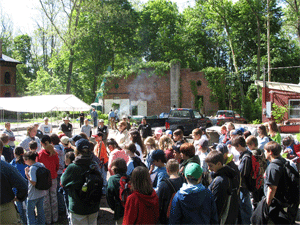Another season of archaeology has begun at the West Point Foundry and the crew is busy peeling back soil layers and rubble around the site. This is our FIFTH season in the field, and we are going to work in at least two different areas over the course of May, June, and July. These pages will contain regular updates and photographs on our progress at the Foundry this summer prepared by students enrolled in the field school. We also encourage you to take advantage of this unique site by visiting us at the Preserve sometime this summer.
In the first few weeks of the field season, we were happy to have Fourth and Sixth Grade visitors from Haldane Central School and are looking forward to our upcoming “DAYS AT THE FOUNDRY” Open House. The “Days at the Foundry” are free and open to the public from 10 AM- 3PM and will be on SATURDAY & SUNDAY, JUNE 17 & 18 as well as over the weekend of JULY 15 & 16. We will be giving tours rain or shine, and you should probably wear sturdy shoes with long pants to avoid ticks. Scenic Hudson is also providing “Foundry Friday” tours in June, July, and August. Keep your eye out on this web page as well as the Putnam County News & Recorder for more details.

Select on photograph to enlarge
Over 50 6th grade students came to the West Point Foundry Preserve to hear presentations about blacksmithing, moulding, park planning, and archaeology on May 22, 2006.
The West Point Foundry produced a variety of iron products during the nineteenth century including steam engines, locomotives, sugar machinery, water system valves, and of course cannons. At their peak of production during the Civil War, there were over 1,000 employees making about one million dollars worth of cannons and projectiles for Union forces annually. The Office Building, built in 1865, still stands on the site. At first glance, it seems to be all that remains of the complex. But in recent years, students enrolled in Michigan Tech's Industrial Archaeology Field School have shown that much more of the foundry still exists in the nearby woods.
Michigan Tech is the only graduate program in North America dedicated to industrial archaeology (exploration of the material culture of people from the industrial time-period). In a partnership with Scenic Hudson, Michigan Tech has spent the last five summers exploring the historic documents, mapping the site, and using archaeology to learn more about the foundry. The site has become a classroom for students to learn about the iron industry and about excavation techniques. This summer, our focus will be on several areas around the site. Building on research from last summer, we have returned to the East Bank House to investigate the domestic side of workers’ lives. In addition, we are “sharpening the edges” of the machine shop, moulding shop, and boring mill by exposing wall foundations.
Students arrived on the evening of May 9 and work began the next day. Students began to learn about the project through orientation to the site, company history, Scenic Hudson’s mission, and Michigan Tech’s earlier field seasons. Training sessions in sketching, map making, scaled drawings, photography, and paperwork occupied our time for the first few days. Despite the rainy weather for the past few weeks, the crew has managed to begin excavation. We did not break any soil until Monday May 15 because archaeology is more about documentation than it is about digging. Once students began using their trowels up at the East Bank House domestic artifacts such as window glass, cut nails, animal bone, brick fragments, ceramic sherds and coal appeared. In the area along the central railroad through the site, we are defining edges of the machine shop and moulding shop by moving building rubble. Students have uncovered brick and granite stone foundations, finding architectural debris like broken bricks and window glass, electrical conduits, nails, various bolts, a wheel for a cart, and broken bottle glass.
You can also look forward to seeing monthly updates about our progress at the West Point Foundry site in a column in the Putnam County News & Recorder. Thanks for visiting us on the web and we look forward to seeing you at the foundry sometime soon!
Elizabeth Norris, Assistant Archaeologist.



